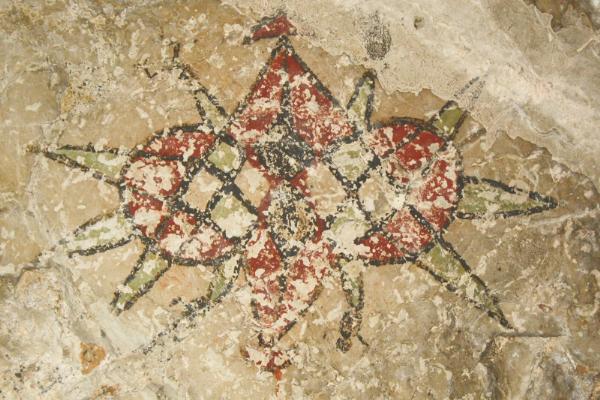Lene Hara

Lene Hara Cave is a large limestone solution cave located in the East Timor in the Indonesian archipelago. Excavated beginning in the 1990s by Sue O'Connor of the Australian National University, Lene Hara has proven to contain several stacked occupations, the oldest between 30,000 and 35,000 years ago. The earliest evidence of pre-Lapita fishing has been found at Lene Hara, in the form of shell fish hooks, made of Trochus niloticus and recently dated between 9741+/- 60 years before the present.
Rock art paintings are visible on the walls of the cave, mostly attributed to the post-pottery Neolithic occupation (ca 2000 years ago). Motifs of the rock art include boats, animals and birds; some combined human and animal forms; and, most frequently, geometric shapes such as sun bursts and star shapes.
Most of the art is monochrome, but pigments of black, yellow and brown and a few of red and green are also noted. Recent efforts to date the rock art using examination of the calcite laminations indicates that while the visible rock art is less than 6300 years old, there are remnants of art beneath that which may date as old as 24,000 years ago.
Geology of East Timor
East Timor land mass is a continental fragment. The foundation is largely made up of limestone and other sedimentary deposits. This differentiates it from its neighbours to the north and west in the Sunda chain, which are volcanic. Lautem District, where is Lene Hara caves situated, has the same geological and geographical features as much of East Timor; the central part of the District, mountains and hills running southwest to northeast, from the south coast to the north coast.
The Lautem plateaus are part of the Viqueque Formation, which was folded in the Late Pliocene time and Timor began to emerge as an island. The post-Pliocene unit was deposited near Baucau town and is called „Baucau Limestone“. The flat lying Baucau Limestone consists of grey, hard, cavernous, massive white coral-reef limestone. The unit controls the topography in the Baucau and Lautem plateaus. A continuous outcrop occurs along the north coast. In the southern foothills, the Baucau Limestone also crops out in scattered hills. The limestone occurs as coral-reef, calcarenite and a greywacke-pebbly sandstone facies. The Baucau Limestone rests unconformably on older units everywhere. It overlies the Viqueque Formation, but locally, it is found on older formations.
Prehistory of East Timor
Timor-Leste is a sedimentary island located in the bio geographic area of Wallacea, between Australia and mainland Southeast Asia. This area has never worked as a land bridge between the two countries and any ancient human migration beyond the Asian continent has thus involved sea crossing.
The history of human occupation in Timor-Leste goes as far back as 35.000 years before the present time. The dates were obtained after the most recent archaeological excavations in the Lene Hara cave, in Tutuala. Back in the 60s and within the work carried out by Ian Glover the first radiocarbon dates confirmed that human populations during prehistoric times, who altered the landscape and induced major geomorphologic impacts due to systematic fires for the introduction of agriculture and domesticates, had settled the island. These communities spoke Austronesian languages and arrived in Timor-Leste between 4.000 and 3.500 years before present time.
Besides Glover’s work the Timor Anthropological Mission, lead by António de Almeida, had already carried out field surveys in Timor-Leste identifying and excavating a number of sites. Among them is Ile Kére Kére with its important and well know rock paintings, initially published by Ruy Cinatti.
Between those works from the 50s and the 60s e the new research initiated in 2000 more then 30 years have passed. The East Timor Archaeological Project has already identified a great number of new archaeological sites and relocated old ones. Besides Lene Hara, other sites have been test pitted or excavated along the North coast and several new radiocarbon dates are available.
The systematic surveying of caves and rock shelters with paintings, especially in Lospalos, has allowed identifying a great number of sites to those previously known, attesting the presence of a rich cultural expression dated in Southeast Asia and the Pacific from at least 2.000 years.
Archaeological research in Timor-Leste is in progress and new fieldwork is being carried out in Lospalos, Baucau and Baguia. After more then 30 years where almost no scientific research was made possible, the recently created country opens its doors to new research projects, taking its well-deserved place in the history of human occupation in Southeast Asia.